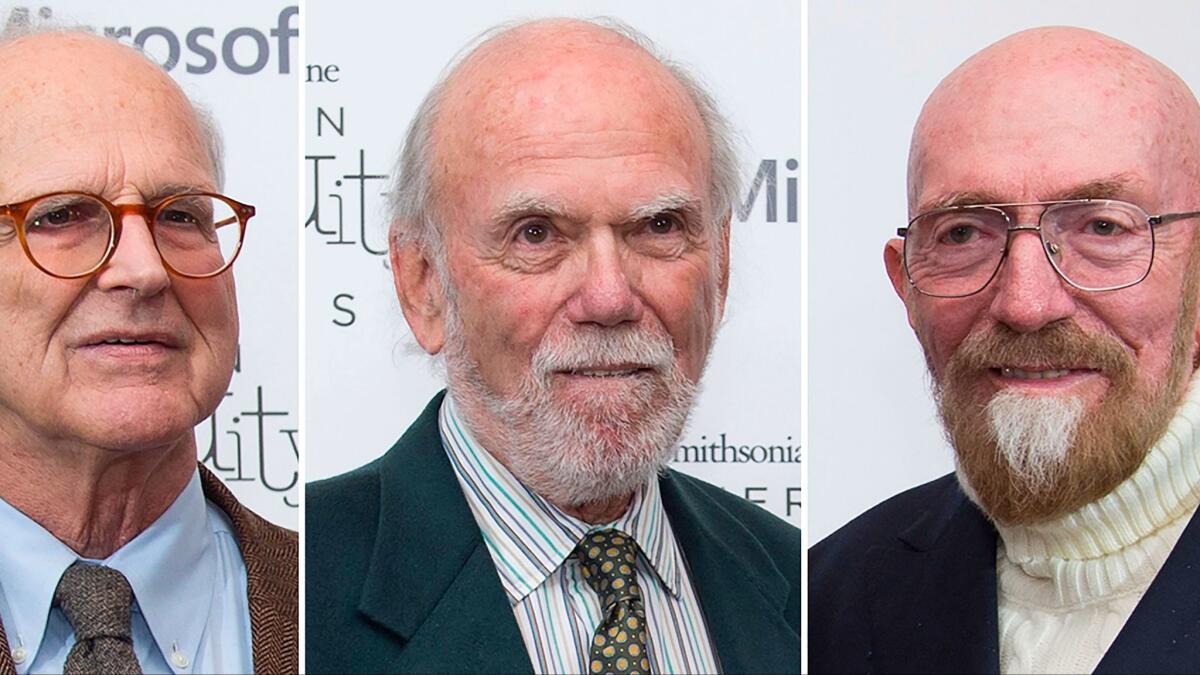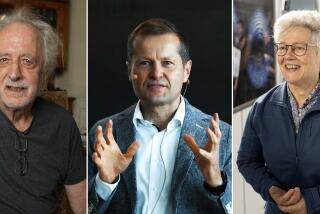2 Caltech scientists share Nobel Prize in physics for gravitational wave discoveries

In 1975, physicists Kip Thorne and Rainer Weiss visited Washington, D.C., for a NASA meeting and wound up sharing a hotel room. One was a theorist from Caltech; the other an experimentalist from MIT. They hardly knew each other. But that night, they ended up talking until around 4 a.m. about building a machine that could detect tiny ripples in the fabric of space-time.
Four decades later, the pair, along with colleague Barry Barish of Caltech, won the Nobel Prize in physics for their discovery of gravitational waves. The feat offered experimental proof of Albert Einsteinâs general theory of relativity and ushered in a new field of astronomy with the potential to reveal the first moments after the Big Bang.
Thorne and Barish split half of the $1.1-million prize, and Weiss received the other half. The men were instrumental players in the creation of LIGO, the Laser Interferometer Gravitational-Wave Observatory.
âWeâre seeing aspects of the universe that could never be seen in any other way,â Thorne said Tuesday after the prize was announced.
On Sept. 14, 2015, and three times since, the LIGO detectors registered slight disturbances in space-time that were 10,000 times smaller than the diameter of an atomic nucleus.
Those minuscule ripples âshook the world,â Olga Botner, a member of the Nobel Committee for Physics, said at a briefing at the Royal Swedish Academy of Sciences in Stockholm.
Thorne said he was awakened by the Nobel committee about 2:15 a.m. and groggily navigated a flight of stairs to the phone ringing loudly in his wifeâs office.
âMy phone never rings around that time of the morning so I was pretty sure what the call was,â he said.
Barish set an alarm in anticipation of the Nobel announcement but heard nothing until 2:41 a.m., four minutes before the presentation in Stockholm was set to begin.
âI assumed when I got up that I didnât get it, because I hadnât heard anything,â he said. âBut a minute later, the phone rang.â
Ronald Drever, Thorneâs colleague and one of LIGOâs co-founders, died in March. The Nobel is only awarded to living scientists.
Long before Copernicus tracked heavenly bodies in the night sky or Galileo pointed his telescope at Jupiter, humans used light to understand the universe. Each time scientists looked beyond the visible portion of the spectrum, they saw the cosmos in a whole new light.
X-rays announced the activity of powerful objects like neutron stars and exploding supernovae. Infrared light revealed the dusty cradles of newborn stars. Radio waves sketched a map of the radiation left over from the Big Bang.
But many things in the cosmos canât be seen with light. By hunting for gravitational waves instead of light waves, LIGO has put a major crack in that barrier to understanding the universe.
Scientists say that gravitational wave detectors could help them understand powerful phenomena that would reveal much about the structure and evolution of the universe. For instance, some are starting to wonder whether LIGO could find the kinds of black holes that would help explain the nature of dark matter, that mysterious stuff that accounts for more than 80% of the mass in the universe and yet cannot be seen.
Gravitational waves are caused by objects as they accelerate or decelerate through space-time. None other than Einstein predicted the existence of these waves in 1916, but they are so faint that he assumed it would be practically impossible to detect them.
LIGO proved that assumption wrong.
The laboratory consists of two identical L-shaped detectors, one in Hanford, Wash., and the other in Livingston, La. If gravitational waves pass through, their 2.5-mile-long arms are alternately squeezed and stretched. A system of lasers and mirrors measures that disturbance.

This short video explains the apparatus that was used to detect gravitational waves passing through the Earth.
In principle, the experiment was straightforward. The challenge was finding ways to dampen the myriad signals â earthquakes, passing trucks, even the vibrations of the Earth â that might be mistaken for gravity waves.
The project struggled for years to find its footing. Barish, brought in to lead the Caltech-MIT collaboration in 1994, was instrumental in getting LIGO designed and built, Thorne said.
âItâs not clear to me that anybody else could have pulled off what he pulled off,â Thorne said.
Construction began in 1994, and LIGOâs first run, largely framed as a proof of principle, lasted from 2002 to 2010. As predicted, no gravitational waves were found.
After significant upgrades and a total of $1.1 billion in funding from the National Science Foundation, the rechristened Advanced LIGO was flipped on in 2015.
The first detection of gravitational waves came quickly: a swan song from a pair of black holes dancing around and toward one another before colliding and releasing gravitational wave energy in the process.
The researchers were so surprised that they worried that the data might have been fake, Weiss said.
âWe thought right away this looked just too beautiful,â he said. But after careful tests, the scientists determined that the signal was real.
LIGO has since detected three more black hole collisions. The most recent of these came in August in collaboration with the European Virgo detector, which has recently come online. More are in the works, including one in India and another in Japan.
This is good news for physicists, because the more detectors there are, the more accurately scientists can locate and study these events.
So far, all four events have been collisions between two black holes, but scientists hope to find other phenomena soon, including smashups involving neutron stars.
Weiss, in a media briefing, hinted that another find would be announced in the coming weeks.
Since the discovery, Weiss, Thorne and Drever have been awarded a 2016 Special Breakthrough Prize in fundamental physics and the 2016 Kavli Prize in astrophysics.
But Thorne emphasized that many of todayâs groundbreaking scientific endeavors are made possible by large, international collaborations. As such, he said, awards should honor the team rather than a few individuals.
âIn reality the prize should be going to the entire LIGO-Virgo collaboration, or to the LIGO scientists who designed, built, and perfected the gravitational wave detectors,â Thorne said. âThat was by far the hardest part of this. Itâs the team that really deserves this award.â
It was a sentiment shared by his co-laureates.
As Weiss spoke during a news conference at MIT, he called on all LIGO team members in the room to stand up â and gave them a round of applause.
Follow @aminawrite on Twitter for more science news and âlikeâ Los Angeles Times Science & Health on Facebook.
READ MORE ABOUT LIGO
How scientists detected gravitational waves for the first time
âWe can hear the universeâ: Scientists detect gravitational waves, predicted by Einstein
Road to the discovery of gravitational waves was riddled with doubt
After LIGO detects a third black hole collision, gravitational wave astronomy is here to stay
Three detectors, two black holes and one really big collision: Gravitational waves found again
UPDATES:
8:15 p.m.: This article was updated with comments from Rainer Weiss and additional information throughout.
10:30 a.m.: This article was updated with comments from Kip Thorne and additional information throughout.
4:15 a.m.: This article was updated with comments from Barry Barish.
This article was originally published at 3 a.m.







